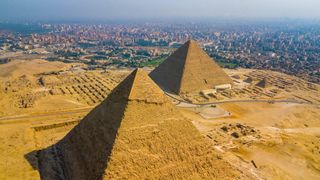
The iconic pyramids of Egypt dot the landscape and were built by pharaohs to be their tombs for
over a millennia. But why did the ancient Egyptians stop building them? (Image credit: Islam
Moawad via Getty Images)
For more than a millennia, Egyptian pharaohs had pyramids constructed and often were buried beneath or within the massive monuments.
Egyptian pharaohs constructed pyramids between the time of King Djoser (reign 2630 to 2611 B.C.), who built a step pyramid at Saqqara, to the time of King Ahmose I (reign 1550 to 1525 B.C.), who built the last known royal pyramid in Egypt at Abydos.
These iconic pyramids displayed the pharaohs' power, wealth and promoted their religious beliefs. So why did the ancient Egyptians stop building pyramids shortly after the New Kingdom began?
In ancient Egypt, pyramid construction appeared to wane after the reign of Ahmose, with pharaohs instead being buried in the Valley of the Kings near the ancient Egyptian capital of Thebes, which is now modern-day Luxor. The Theban Mapping Project notes on their website that the earliest confirmed royal tomb in the valley was built by Thutmose I (reign 1504 to 1492 B.C.). His predecessor Amenhotep I (reign 1525 to 1504 B.C.) may also have had his tomb built in the Valley of the Kings, although this is a matter of debate among Egyptologists.
Why stop?
It's not entirely clear why pharaohs stopped building royal pyramids, but security concerns could have been a factor.
"There are plenty of theories, but since pyramids were inevitably plundered, hiding the royal burials away in a distant valley, carved into the rock and presumably with plenty of necropolis guards, surely played a role," Peter Der Manuelian, an Egyptology professor at Harvard University, told Live Science in an email.
"Even before they gave up on pyramids for kings, they had stopped placing the burial chamber under the pyramid. The last king's pyramid — that of Ahmose I, at Abydos — had its burial chamber over 0.5 km [1,640 feet] away, behind it, deeper in the desert," Aidan Dodson, an Egyptology professor at the University of Bristol, told Live Science in an email. READ MORE...
For more than a millennia, Egyptian pharaohs had pyramids constructed and often were buried beneath or within the massive monuments.
Egyptian pharaohs constructed pyramids between the time of King Djoser (reign 2630 to 2611 B.C.), who built a step pyramid at Saqqara, to the time of King Ahmose I (reign 1550 to 1525 B.C.), who built the last known royal pyramid in Egypt at Abydos.
These iconic pyramids displayed the pharaohs' power, wealth and promoted their religious beliefs. So why did the ancient Egyptians stop building pyramids shortly after the New Kingdom began?
In ancient Egypt, pyramid construction appeared to wane after the reign of Ahmose, with pharaohs instead being buried in the Valley of the Kings near the ancient Egyptian capital of Thebes, which is now modern-day Luxor. The Theban Mapping Project notes on their website that the earliest confirmed royal tomb in the valley was built by Thutmose I (reign 1504 to 1492 B.C.). His predecessor Amenhotep I (reign 1525 to 1504 B.C.) may also have had his tomb built in the Valley of the Kings, although this is a matter of debate among Egyptologists.
Why stop?
It's not entirely clear why pharaohs stopped building royal pyramids, but security concerns could have been a factor.
"There are plenty of theories, but since pyramids were inevitably plundered, hiding the royal burials away in a distant valley, carved into the rock and presumably with plenty of necropolis guards, surely played a role," Peter Der Manuelian, an Egyptology professor at Harvard University, told Live Science in an email.
"Even before they gave up on pyramids for kings, they had stopped placing the burial chamber under the pyramid. The last king's pyramid — that of Ahmose I, at Abydos — had its burial chamber over 0.5 km [1,640 feet] away, behind it, deeper in the desert," Aidan Dodson, an Egyptology professor at the University of Bristol, told Live Science in an email. READ MORE...
No comments:
Post a Comment